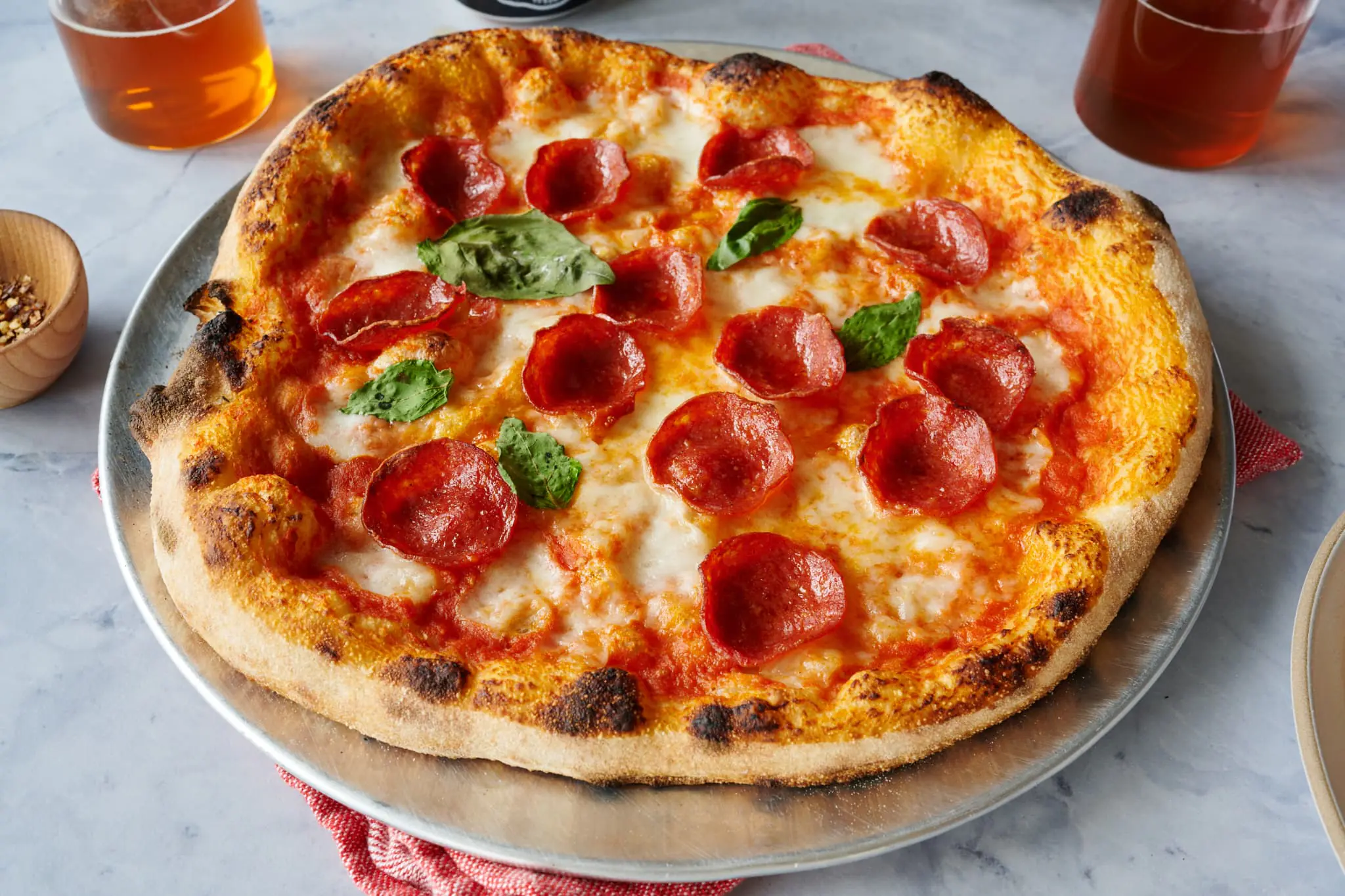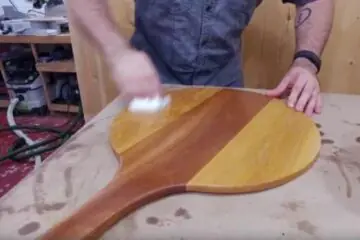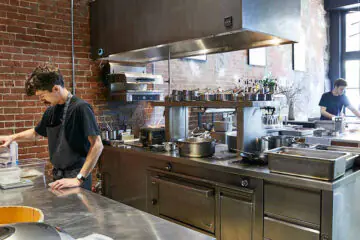To prevent the pizza from burning on a pizza stone, preheat the stone properly and ensure an even distribution of heat. Now, let’s dive into more details about this common challenge faced by pizza enthusiasts.
A hot and crispy pizza fresh from the oven can be a delightful treat. However, sometimes, the pizza base ends up burnt while the toppings remain undercooked. This can be frustrating, especially when you’ve put in the effort to make a homemade pizza or ordered from your favorite pizzeria.
One common culprit behind burnt pizza is a pizza stone that is too hot. When the stone becomes extremely hot, it can quickly scorch the bottom of the pizza before the toppings can cook properly. To prevent this, it’s essential to preheat the pizza stone thoroughly. Additionally, ensuring the even distribution of heat across the stone surface during baking can also help prevent burning. In the following sections, we will discuss some practical tips and techniques to stop pizza from burning on a pizza stone. By following these guidelines, you can enjoy a perfectly cooked pizza with a golden, crispy crust.
Understanding The Common Problem: Pizza Burning On Pizza Stone
If you’re tired of your pizza burning on a pizza stone, here are some simple tips to prevent it. Adjusting the temperature, preheating the stone, using parchment paper, and making sure your pizza is evenly cooked can help you achieve a perfect, non-burnt crust.
One of the most frustrating issues many home pizza enthusiasts face is the burning of their pizzas when using a pizza stone. It can be disheartening to spend time and effort preparing a delicious homemade pizza only to have it come out charred and inedible. Understanding the factors that contribute to pizza burning on a pizza stone is crucial in finding a solution to this problem. In this section, we will explore these factors and the importance of addressing this issue early on.
Factors Contributing To Pizza Burning
Several factors can contribute to pizza burning on a pizza stone. By identifying these factors, you can take proactive steps to prevent burning and achieve perfectly baked pizzas every time. Here are some common contributors:
| Factors | Solutions |
|---|---|
| Inadequate preheating of the pizza stone | Ensure the stone is properly preheated according to the manufacturer’s instructions. This step allows the stone to distribute heat and prevent burning evenly. |
| High oven temperature | Adjust the oven temperature to a lower setting. Too high of a temperature can cause the bottom of the pizza to burn before the toppings are fully cooked. |
| Thin pizza crust | Opt for a slightly thicker crust to provide a buffer between the stone and the toppings. This can help prevent direct contact and subsequent burning. |
| Uneven dough stretching | Ensure the dough is stretched evenly to avoid thin spots that may cook faster and result in burning. |
Importance Of Addressing The Issue Early On
Addressing the issue of pizza burning on a pizza stone early on is vital to enjoying consistently delicious pizzas. Ignoring the problem may lead to a series of disappointing results and discourage you from using your pizza stone altogether. By taking action and understanding the factors that contribute to burning, you can make necessary adjustments to improve your pizza-making skills. Whether you’re a beginner or an experienced pizzaiolo, addressing this issue will help you master the art of baking perfect pizzas.
Choosing The Right Pizza Stone For Perfect Results
When it comes to baking the perfect pizza at home, a pizza stone is an essential tool. Not only does it help achieve a crisp and evenly cooked crust, but it also adds a touch of that authentic pizzeria flavor. However, to stop the problem of pizza burning on a pizza stone, it’s essential to choose the right one that suits your needs. In this article, we’ll explore the different types of pizza stones available and provide you with key factors to consider when evaluating their suitability.
Different Types Of Pizza Stones To Consider
Before diving into the details, let’s take a look at the different types of pizza stones you can consider for a perfect pizza-making experience:
| Type | Description |
|---|---|
| Cordierite Stone | Cordierite stones are known for their excellent heat retention properties and durability. Their porous nature absorbs moisture, resulting in a crispy crust. |
| Clay Stone | Clay stones are ideal for those seeking a traditional, rustic pizza taste. These stones heat up slowly and evenly, giving your pizza a brick oven-like flavor. |
| Cast Iron Stone | Cast iron stones are renowned for their exceptional heat retention capabilities. They distribute heat evenly, producing a golden-brown crust. |
| Steel Stone | Steel stones are gaining popularity due to their ability to heat up quickly and retain heat effectively. They produce a crispy crust with a chewy texture. |
| Composite Stone | Composite stones consist of a blend of materials such as cordierite, ceramic, and clay. They offer a balance between heat retention, durability, and even cooking. |
Evaluating The Heat-retention Properties
When evaluating a pizza stone, it’s crucial to consider its heat-retention properties. The ability to retain heat ensures a consistent and even cooking process. Look for stones that have high thermal mass, such as cordierite or cast iron, as they will retain heat well and help prevent burning.
Ensuring Proper Thickness And Size For Even Heat Distribution
In addition to heat retention, the thickness and size of your pizza stone play a significant role in achieving even heat distribution. A thick stone will retain heat better and distribute it evenly across the surface, resulting in a perfectly cooked pizza. Moreover, the size of the stone should match the size of your oven to ensure efficient heat circulation.
By selecting the right pizza stone considering factors such as type, heat-retention properties, thickness, and size, you can avoid the issue of burning your precious pies. So, take the time to research and choose a suitable pizza stone that will leave you with delicious, evenly cooked pizzas every time.
Preparing The Pizza Stone For Optimal Performance
Preparing the pizza stone is essential for achieving optimal performance and ensuring that your pizza cooks evenly without burning. There are a few key steps you can take to prepare your pizza stone effectively. In this section, we will discuss how to season the stone to create a non-stick surface, properly preheat the stone to the ideal temperature, and use parchment paper or cornmeal to prevent sticking and burning. By following these steps, you’ll be able to enjoy delicious, perfectly cooked pizzas every time.
Seasoning The Pizza Stone For Non-stick Properties
Seasoning your pizza stone is crucial for creating a non-stick surface that promotes even heat distribution. To season your pizza stone, follow these simple steps:
- Wash the stone with warm water and a gentle dish soap. Rinse thoroughly and allow it to dry completely.
- Apply a thin coating of vegetable oil or olive oil to the entire surface of the stone, including the edges.
- Place the stone in a preheated oven at 350°F (175°C) for about one hour.
- After one hour, turn off the oven and allow the stone to cool completely.
- Once the stone is cool, wipe off any excess oil with a clean cloth.
By seasoning your pizza stone regularly, you’ll develop a natural, non-stick coating that enhances the cooking process.
Properly Preheating The Stone To The Ideal Temperature
Preheating your pizza stone is crucial for achieving the perfect crust. Here’s how you can properly preheat your stone:
- Place the pizza stone in the cold oven.
- Turn the oven to the desired temperature, typically around 475°F (245°C), and allow the stone to heat up along with the oven. Preheating the stone with the oven ensures that it reaches the optimal temperature for baking.
- Let the stone preheat for at least 30 minutes to ensure it’s thoroughly heated.
Proper preheating ensures that the stone absorbs and distributes heat evenly throughout the cooking process, resulting in a crispy, well-cooked pizza.
Using Parchment Paper Or Cornmeal To Prevent Sticking And Burning
To prevent your pizza from sticking to the stone and burning, you can use parchment paper or cornmeal as a protective barrier:
- Parchment paper: Cut a piece of parchment paper to fit the size of your pizza and place it directly on the stone. The paper will create a barrier between the dough and the stone, preventing sticking and burning. Remember to remove the parchment paper halfway through the cooking process to allow the crust to crisp up.
- Cornmeal: Sprinkle a generous amount of cornmeal onto the pizza stone before placing your dough on top. The cornmeal acts as a natural lubricant, preventing sticking and adding a delightful crunch to the crust.
By using either parchment paper or cornmeal, you’ll ensure that your pizza slides off the stone effortlessly and remains perfectly cooked.
:max_bytes(150000):strip_icc()/Best-Pizza-Ovens-Tested-FW-Social-09dbf874b2d14e568f9be9749cf9626c.jpg)
Credit: www.foodandwine.com
Techniques To Prevent Pizza Burning On Pizza Stone
If you’re an enthusiast of homemade pizzas, chances are you’ve invested in a pizza stone to achieve that crispy crust and melty cheese. However, nothing is more disappointing than producing a perfectly crafted pizza only to find that it has burned on the bottom. But fear not! There are several techniques you can employ to prevent your pizza from burning on the pizza stone. In this article, we will discuss three effective methods: adjusting the oven temperature and rack placement, monitoring cooking time for desired results, and rotating the pizza for even cooking and browning.
Adjusting Oven Temperature And Rack Placement
When it comes to preventing pizza burning, oven temperature and rack placement play a vital role. Firstly, it’s essential to preheat your oven, including the pizza stone, to the desired temperature. This will ensure even heat distribution and minimize the chances of burning. Typically, a temperature of 450°F to 500°F (232°C to 260°C) is recommended for pizza baking.
However, each oven is different, and you may need to experiment with different temperatures to find the perfect balance for your pizza. If your pizza consistently burns on the bottom, consider lowering the oven temperature by 25°F (14°C) and adjusting accordingly until you achieve the desired results.
Rack placement is equally crucial in preventing pizza burning. Placing the pizza stone on the lowest rack of the oven allows the heat to circulate more evenly, reducing the risk of burning. Additionally, ensure that the stone is positioned in the center of the rack to achieve optimal heat absorption.
Monitoring Cooking Time For Desired Results
The key to perfectly cooked pizza lies in carefully monitoring the cooking time. It is essential to follow the recommended cooking time specified in your recipe or pizza dough instructions. Overcooking can quickly lead to burning, especially when using a pizza stone.
Keep a close eye on the pizza during the final few minutes of cooking. This ensures that you achieve your desired level of doneness without risking burning. Remember, every oven is unique, so your cooking time may vary from what the recipe suggests. Use the recommended time as a guideline, but trust your instincts and adjust as needed.
Rotating The Pizza For Even Cooking And Browning
Another effective technique for preventing pizza burning is to rotate the pizza during the baking process. By ensuring that the pizza cooks evenly on all sides, you minimize the chances of burning on one particular spot.
About halfway through the cooking process, carefully rotate the pizza using a pizza peel or oven-safe gloves. This allows different parts of the pizza to come in contact with varying heat levels, resulting in an evenly cooked and beautifully browned pizza.
Continue to rotate the pizza every few minutes until it is fully cooked. This technique not only prevents burning but also helps achieve that desired crispy crust throughout the pizza.
By employing these techniques, you can enjoy flawless pizzas with crispy crusts and perfectly melted cheese every time. Remember to adjust the oven temperature and rack placement, monitor cooking time for desired results, and rotate the pizza during baking. With these strategies in your arsenal, burnt pizzas will be a thing of the past!
Additional Tips And Tricks For Perfect Homemade Pizzas
If you want to take your homemade pizzas to the next level, here are some additional tips and tricks that will help you achieve pizza perfection. From using a pizza peel for easy transfer to experimenting with different toppings and cheese combinations, these techniques will ensure that each slice of your pizza is a slice of heaven.
Using A Pizza Peel For Easy Transfer To And From The Stone
One of the keys to achieving a perfectly cooked pizza is being able to easily transfer it to and from the hot pizza stone. A pizza peel is a must-have tool for this task. It is a flat, shovel-like instrument used to slide the pizza onto the stone and remove it once it is done.
Here are some tips for using a pizza peel effectively:
- Make sure the surface of the peel is well-floured or lightly dusted with cornmeal to prevent the dough from sticking.
- Gently slide the peel under the pizza, starting from the back and working your way towards the front. Be careful not to disturb the toppings or shape of the pizza.
- Once the pizza is on the peel, please give it a gentle shake to ensure it moves freely before sliding it onto the hot stone.
- When removing the pizza from the stone, use the peel to gently slide it back onto the peel, again starting from the back and working your way towards the front.
Properly Stretching And Shaping The Dough To Avoid Uneven Cooking
The way you stretch and shape the pizza dough will greatly impact the cooking process. Improper stretching and shaping can result in a pizza that cooks unevenly or burns in certain areas. Follow these tips to ensure even cooking:
- Start by letting the dough rest at room temperature for about 30 minutes to relax the gluten and make it easier to work with.
- Lightly flour your work surface and gently press the dough into a flat disc.
- Using your hands, gently stretch the dough from the center towards the edges, being careful not to tear it.
- Flip the dough over and continue stretching and shaping until you achieve the desired size and thickness.
- If the dough starts to shrink back, let it rest for a few minutes before continuing.
Experimenting With Different Toppings And Cheese Combinations For Flavor Enhancement
While the crust and cooking process are important, the toppings and cheese can make or break a homemade pizza. Get creative and try different flavor combinations to enhance your pizzas. Consider the following tips:
| Topping Ideas | Cheese Combinations |
|---|---|
|
|
|
|
Remember to leave your pizza with toppings and cheese, as it can result in an overly heavy and soggy crust. Find the right balance and allow the flavors to shine.
Frequently Asked Questions For How To Stop Pizza Burning On Pizza Stone
How Do I Prevent My Pizza From Burning On A Pizza Stone?
To prevent your pizza from burning on a pizza stone, it’s important to preheat the stone properly and use the right temperature. Additionally, cooking the pizza for the right amount of time and using a pizza peel to transfer it to and from the stone can help prevent burning.
Why Is My Pizza Burning On The Pizza Stone?
If your pizza is burning on the pizza stone, it could be due to a few reasons. One common reason is that the stone is too hot, so make sure to preheat it properly. Another reason could be that the pizza is cooking for too long or at too high of a temperature.
Adjusting these factors can help prevent burning.
Can I Use Parchment Paper To Prevent My Pizza From Burning On The Pizza Stone?
Yes, using parchment paper can be a great way to prevent your pizza from burning on the pizza stone. Simply place the parchment paper on the stone before placing the pizza on top. The parchment paper acts as a barrier and helps distribute heat evenly, preventing the pizza from burning.
Conclusion
To avoid pizza burning on a pizza stone, follow these simple tips: preheat your stone properly, use parchment paper or a pizza peel, control the temperature of your oven, and experiment with different cooking times. By taking these precautions, you can enjoy perfectly cooked pizzas every time.
Don’t let burnt pizza ruin your meal—take charge and savor the deliciousness!

As the author of the “Ultimate Pizza Guide: Recipes, Tips & Secrets Revealed,” I’m dedicated to sharing my love for pizza and empowering others to create delicious homemade pizzas with ease. Join me on a journey to uncover the secrets to perfecting your pizza game!



